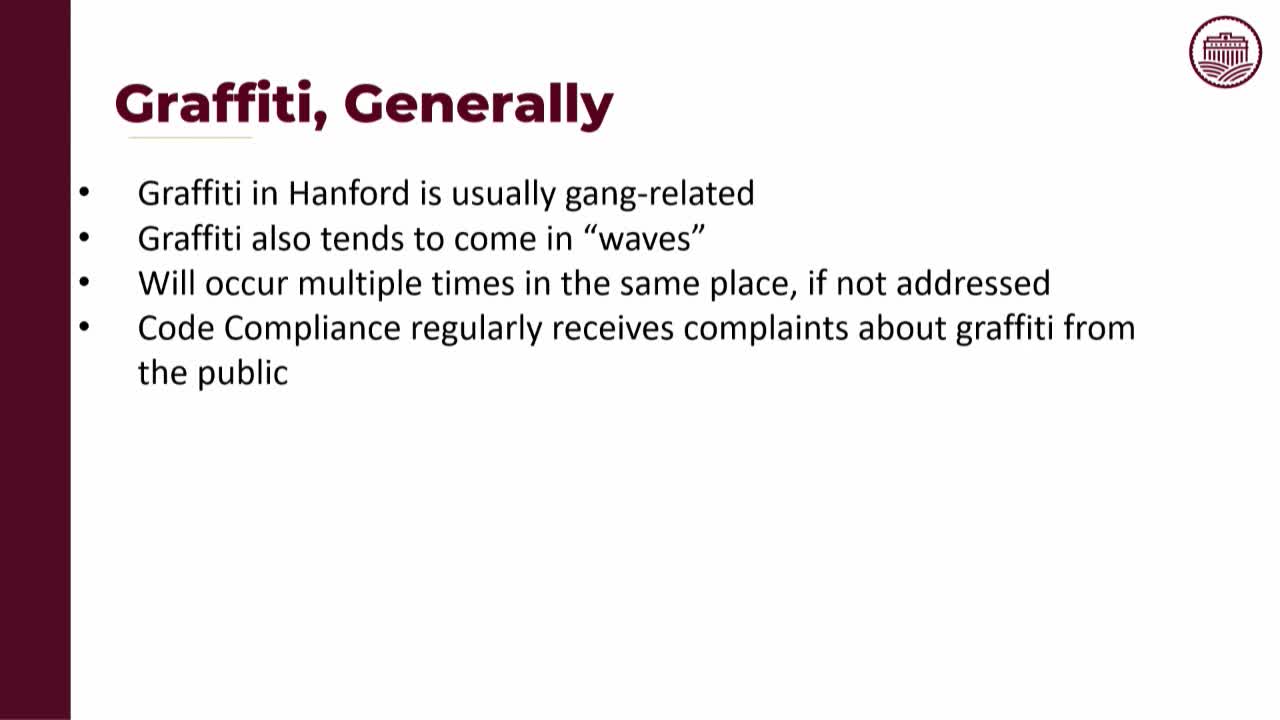Hanford City Council Proposes New Graffiti Abatement Ordinance Ending Citations for Property Owners
October 07, 2025 | Hanford, Kings County, California
This article was created by AI summarizing key points discussed. AI makes mistakes, so for full details and context, please refer to the video of the full meeting. Please report any errors so we can fix them. Report an error »

During a recent City Council meeting in Hanford, California, officials discussed a proposed ordinance aimed at addressing the persistent issue of graffiti in the community. Graffiti has been a significant concern for residents, often linked to gang activity and frequently reported as a public nuisance. The current approach allows the city to issue citations and fines to property owners for graffiti on their property, which has drawn criticism for penalizing victims rather than the perpetrators.
The proposed ordinance seeks to shift this approach by removing graffiti from the list of public nuisances. Instead of citations, property owners would be given a 30-business-day period to clean up graffiti, with the city offering assistance through an alternative abatement agreement. This agreement would allow the city to clean the graffiti at the property owner's expense if they fail to act within the designated timeframe. The ordinance also maintains penalties for individuals applying graffiti and for minors possessing graffiti implements.
Council members expressed support for the changes, emphasizing the need for the city to hold itself to the same standards as private property owners in addressing graffiti. The Planning Commission recommended that the city also be required to clean graffiti on public property within the same 30-day timeframe.
Public comments during the meeting highlighted mixed feelings about the ordinance. Some residents supported the abatement efforts, while others argued that the ordinance still unfairly penalizes property owners for crimes committed by others. Concerns were raised about the effectiveness of the proposed measures and the need for better enforcement of existing laws against graffiti vandalism.
As the council deliberates on the ordinance, the discussions reflect a broader community desire to find effective solutions to the graffiti problem while ensuring that property owners are not unduly burdened. The council plans to review the feedback and may make adjustments before finalizing the ordinance.
The proposed ordinance seeks to shift this approach by removing graffiti from the list of public nuisances. Instead of citations, property owners would be given a 30-business-day period to clean up graffiti, with the city offering assistance through an alternative abatement agreement. This agreement would allow the city to clean the graffiti at the property owner's expense if they fail to act within the designated timeframe. The ordinance also maintains penalties for individuals applying graffiti and for minors possessing graffiti implements.
Council members expressed support for the changes, emphasizing the need for the city to hold itself to the same standards as private property owners in addressing graffiti. The Planning Commission recommended that the city also be required to clean graffiti on public property within the same 30-day timeframe.
Public comments during the meeting highlighted mixed feelings about the ordinance. Some residents supported the abatement efforts, while others argued that the ordinance still unfairly penalizes property owners for crimes committed by others. Concerns were raised about the effectiveness of the proposed measures and the need for better enforcement of existing laws against graffiti vandalism.
As the council deliberates on the ordinance, the discussions reflect a broader community desire to find effective solutions to the graffiti problem while ensuring that property owners are not unduly burdened. The council plans to review the feedback and may make adjustments before finalizing the ordinance.
View full meeting
This article is based on a recent meeting—watch the full video and explore the complete transcript for deeper insights into the discussion.
View full meeting
